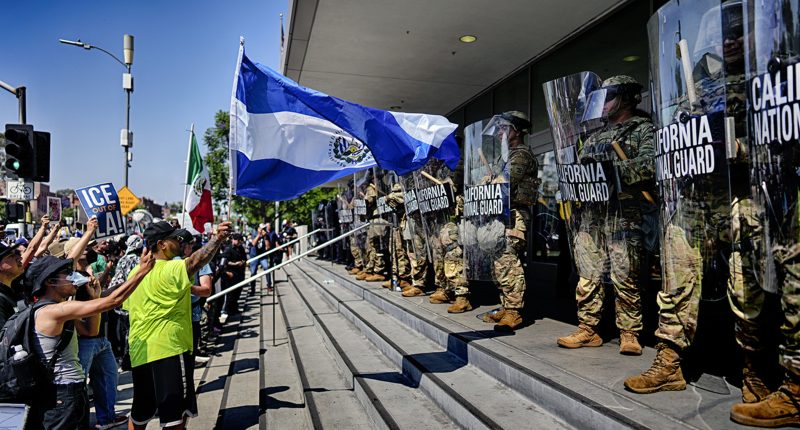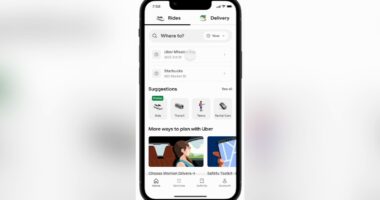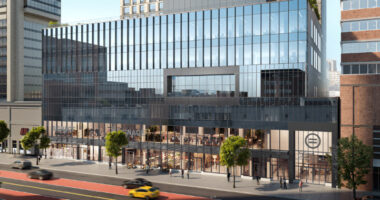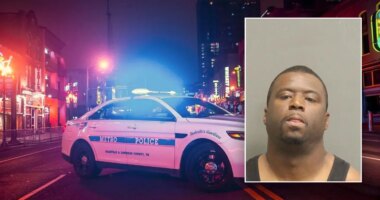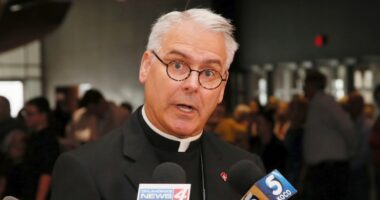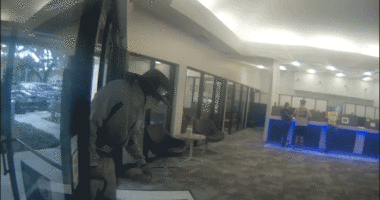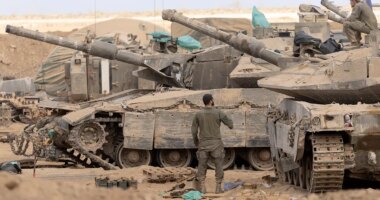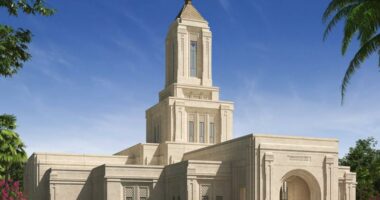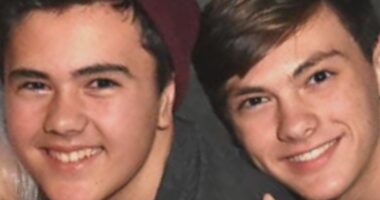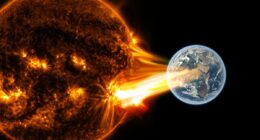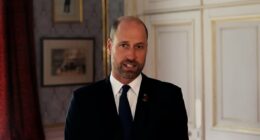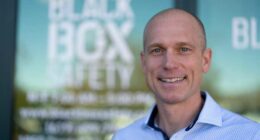Share this @internewscast.com
LOS ANGELES — The deployment of National Guard troops and Marines to Los Angeles is expected to cost at least $134 million and will endure for at least the next 60 days, according to Defense Secretary Pete Hegseth and a senior defense official who informed lawmakers on Tuesday.
According to the Marine Corps commandant on Tuesday, the Marines deployed to Los Angeles under orders from President Donald Trump have not been called to intervene in the city’s immigration protests and are present solely to safeguard federal property.
On Monday, 700 Marines along with an additional 2,000 National Guard troops were dispatched to LA, intensifying a military presence that local officials and Governor Gavin Newsom oppose, and which the police chief indicates complicates the safe management of the protests.

A protester waves a National Flag of El Salvador in front of a line of California National Guard in front of Federal Building on Monday, June 9, 2025, in downtown Los Angeles.
AP Photo/Eric Thayer
“We stated very publicly that it’s 60 days because we want to ensure that those rioters, looters and thugs on the other side assaulting our police officers know that we’re not going anywhere,” Hegseth told members of the House appropriations defense subcommittee.
After persistent questioning from members of Congress, Hegseth turned to his acting comptroller, Bryn Woollacott MacDonnell, who provided the total and said this “is largely just the cost of travel, housing and food.”
She said the money will come from operations and maintenance accounts.
Marine Corps Gen. Eric Smith told a budget hearing on Capitol Hill that the battalion has not yet been sent to any protests. The Marines were trained for crowd control but have no arrest authority and are there to protect government property and federal personnel, he said.
Trump doubled the number of Guard troops being deployed soon after the first wave of 2,000 began arriving Sunday following days of protests driven by anger over the president’s stepped-up enforcement of immigration laws that critics say are breaking apart migrant families.
The demonstrations continued Monday but were far less raucous, with thousands of people peacefully attending a rally at City Hall and hundreds more protesting outside a federal complex that includes a detention center where some immigrants are being held following workplace raids across the city.
The protests in Los Angeles, a city of 4 million people, have largely been centered in several blocks of downtown. At daybreak Tuesday, guard troops were stationed outside the detention center, but there was no sign of the Marines.
Trump has described Los Angeles in dire terms that Mayor Karen Bass and Newsom say are nowhere close to the truth. They say he is putting public safety at risk by adding military personnel even though police say they don’t need the help.
Los Angeles Police Chief Jim McDonnell said in a statement that he was confident in the police department’s ability to handle large-scale demonstrations and that the Marines’ arrival without coordinating with the police department would present a “significant logistical and operational challenge.”
Newsom called the deployments reckless and “disrespectful to our troops” in a post on the social platform X.
“This isn’t about public safety,” the governor said. “It’s about stroking a dangerous President’s ego.”
The protests began Friday after federal immigration authorities arrested more than 40 people across the city. The smell of smoke hung in the air downtown Monday, a day after crowds blocked a major freeway and set self-driving cars on fire as police responded with tear gas, rubber bullets and flash-bang grenades.
Protests against the immigration raids spread Monday to other cities nationwide, including San Francisco and Santa Ana, California, as well as Dallas and Austin, Texas. Authorities in Austin appeared to use chemical irritants to disperse a crowd that gathered near the state Capitol. Texas Gov. Greg Abbott posted on social media that more than a dozen protesters were arrested.
California pushes back against presence of federal troops
California Attorney General Rob Bonta filed a lawsuit over the use of National Guard troops following the first deployment, telling reporters that Trump had “trampled” the state’s sovereignty.
“We don’t take lightly to the president abusing his authority and unlawfully mobilizing California National Guard troops,” Bonta said. He sought a court order declaring Trump’s use of the Guard unlawful and asking for a restraining order to halt the deployment.
Trump said the city would have been “completely obliterated” if he had not deployed the Guard.
U.S. officials said the Marines were needed to protect federal buildings and personnel, including immigration agents. A convoy of buses with blacked-out windows and escorted by sheriff’s vehicles, left the base at Twentynine Palms in the desert east of Los Angeles late Monday and headed toward the city, stopping overnight at Naval Weapons Station Seal Beach, south of LA.
Despite their presence, there has been limited engagement so far between the Guard and protesters while local law enforcement implements crowd control.
Protests remained peaceful Monday
Thousands flooded the streets around City Hall for a union rally Monday before a hearing for arrested labor leader David Huerta, who was freed a few hours later on a $50,000 bond. Huerta’s arrest Friday while protesting immigration raids became a rallying cry for people angry over the crackdown. He is the president of the Service Employees International Union California, which represents thousands of the state’s janitors, security officers and other workers.
Protesters danced and linked hands in front of a line of police officers outside the downtown federal detention center where Huerta was being held. Religious leaders joined the protesters, working with organizers at times to de-escalate moments of tension.
As the crowd thinned, police began pushing protesters away from the area, firing crowd-control munitions as people chanted, “Peaceful protest.” Officers became more aggressive in their tactics in the evening, occasionally surging forward to arrest protesters that got too close. At least a dozen people were surrounded by police and detained.
Outside a clothing warehouse in LA County, relatives of detained workers demanded at a news conference that their loved ones be released.
The family of Jacob Vasquez, 35, who was detained Friday at the warehouse, where he worked, said they had yet to receive any information about him.
“Jacob is a family man and the sole breadwinner of his household,” Vasquez’s brother, Gabriel, told the crowd. He asked that his last name not be used, fearing being targeted by authorities.
Several dozen people were arrested throughout the weekend protests. Authorities say one was detained Sunday for throwing a Molotov cocktail at police and another for ramming a motorcycle into a line of officers.
Guard deployment is a nearly unprecedented escalation
The deployment appeared to be the first time in decades that a state’s National Guard was activated without a request from its governor, a significant escalation against those who have sought to hinder the administration’s mass deportation efforts.
The last time the National Guard was activated without a governor’s permission was in 1965, when President Lyndon B. Johnson sent troops to protect a civil rights march in Alabama, according to the Brennan Center for Justice.
In a directive Saturday, Trump invoked a legal provision allowing him to deploy federal service members when there is “a rebellion or danger of a rebellion against the authority of the Government of the United States.”
___
Sullivan reported from Minneapolis and Baldor reported from Washington. Associated Press writers Dorany Pineda in Los Angeles, Amy Taxin in Orange County, California, Hallie Golden in Seattle, Stefanie Dazio in Berlin, Jake Offenhartz in New York, and Greg Bull in Seal Beach, California contributed to this report.
Copyright © 2025 by The Associated Press. All Rights Reserved.
